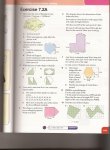The question I'm asking about is question 3.c here:

The question expects you to work it out using algebra even though it's easy to see that the triangles in the trapezium are congruent. From this I can see that 2/3 of the trapezium is shaded-but I can't seem to get this using algebra. here's what I tried:
Are of trapezium = 1/2(a+b)h
The area of the combined shaded triangles will be - 2[1/2(1/2bh)] =2(1/4bh) = 1/2bh. So the proportion will be:
(1/2bh)1/(2ah+1/2bh)
can't get this to equate to 2/3 ! Clearly something faulty I can't see (but will result in me slapping my forehead shouting out dooooh! when someone points it out.
Help appreciatively received.

The question expects you to work it out using algebra even though it's easy to see that the triangles in the trapezium are congruent. From this I can see that 2/3 of the trapezium is shaded-but I can't seem to get this using algebra. here's what I tried:
Are of trapezium = 1/2(a+b)h
The area of the combined shaded triangles will be - 2[1/2(1/2bh)] =2(1/4bh) = 1/2bh. So the proportion will be:
(1/2bh)1/(2ah+1/2bh)
can't get this to equate to 2/3 ! Clearly something faulty I can't see (but will result in me slapping my forehead shouting out dooooh! when someone points it out.
Help appreciatively received.
